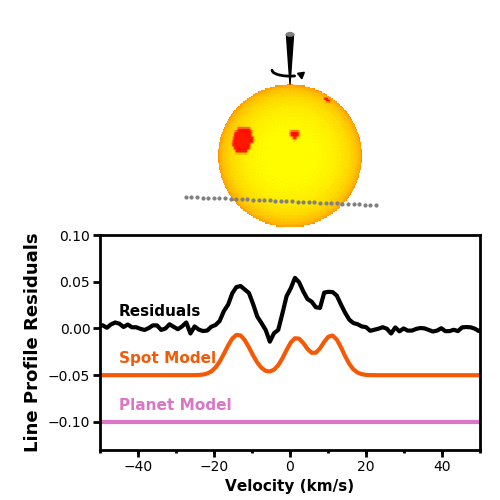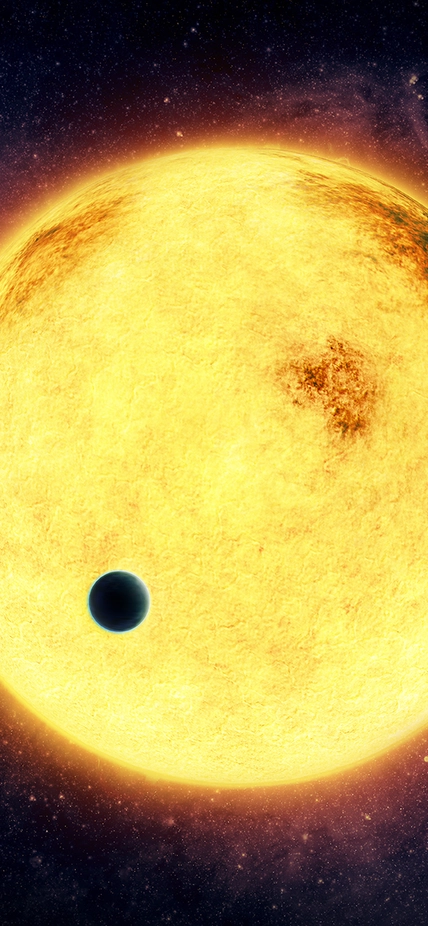Pasadena, CA— A new kind of astronomical observation helped reveal the possible evolutionary history of a baby Neptune-like exoplanet.
To study a very young planet called DS Tuc Ab, a Harvard & Smithsonian Center for Astrophysics-led team that included six Carnegie astronomers—Johanna Teske, Sharon Wang, Stephen Shectman, Paul Butler, Jeff Crane, and Ian Thompson—developed a new observational modeling tool. Their work will be published in The Astrophysical Journal Letters and represents the first time the orbital tilt of a planet younger than 45 million years—or about 1/100th the age of the Solar System—has been measured.
“A lot of things can happen between when a planet is formed and when we see them,” said lead author George Zhou of the CfA. “The vast majority of planets we find are already mature and we don’t know what they were like when they were young.”
DS Tuc Ab is a hot Neptune, which orbits one star in a two-star system on a short, eight-day period in a relatively flat plane.
“DS Tuc Ab is at an interesting age," because the rotating disk of gas and dust from which it formed around its host star has dissipated, explained Ben Montet of the University of New South Wales, who was the lead author of a companion paper on which the Carnegie group were also co-authors that was published in The Astronomical Journal and used a different technique to study the planet. “We can see the planet, but we thought it was still too young for the orbit of other distant stars to manipulate its path.”
DS Tuc Ab was discovered in 2019 by Dartmouth’s Elisabeth Newton and her team using data from NASA’s TESS Mission. A parallel discovery paper was published the same year by scientists the National Institute for Astrophysics in Italy.
Soon after, researchers began observing the planet using the Planet Finder Spectrograph on the Magellan Clay Telescope at Carnegie’s Las Campanas Observatory in Chile. Their goal was to determine whether the newly formed planet had experienced some chaotic dynamical interactions in its past. Astronomers often find planets around other stars in orbits wildly different to the planets in our own Solar System. Some have been found in polar, and even retrograde orbits, because of tugs from outer planets.
 To answer this question, the researchers observed DS Tuc Ab as it passed in front of its host star to measure the effect that the planet had on the starlight. If the planet blocked an equal amount of light as it passed across the surface of the star, for example, this would indicate a well-aligned orbit.
To answer this question, the researchers observed DS Tuc Ab as it passed in front of its host star to measure the effect that the planet had on the starlight. If the planet blocked an equal amount of light as it passed across the surface of the star, for example, this would indicate a well-aligned orbit.
However, an abundance of stellar spots on DS Tuc Ab’s host star made this measurement very difficult. To combat these challenges and characterize the planet and star system, scientists developed their new technique to track the young planet in its orbit. They accomplished this by simultaneously modeling how the planet blocked light across the stellar surface and how the star’s cool spots changed the intrinsic light it was emitting.
“Going forward, this system will allow astronomers to develop a better understanding of planets in their infancy,” said Teske. “We’re especially interested in how ‘hot Neptunes’ move or form so close to their host stars.”
This has been a longstanding astronomical mystery that DS Tuc Ab might be perfectly positioned to help solve. Its youth means it probably didn’t form farther out and get kicked closer to its host by a collision or other external force. But its relatively flat orbital tilt indicate that it wasn’t pulled into this position by interaction with its host star’s companion, either.
“This is a very special system that could teach us so much about the earliest stages of how planetary systems evolve,” Teske added.
Top Image Caption: Artist's concept of DS Tuc AB, which is now the youngest planet for which scientists have measured orbital tilt. Illustration by M. Weiss, CfA.
Bottom Image Caption: Animation courtesy of George Zhou, CfA. Top right illustration of DS Tuc AB by M Weiss, CfA.
__________________
This work was supported by the Heising-Simons Foundation, and a NASA through Hubble Fellowship.
